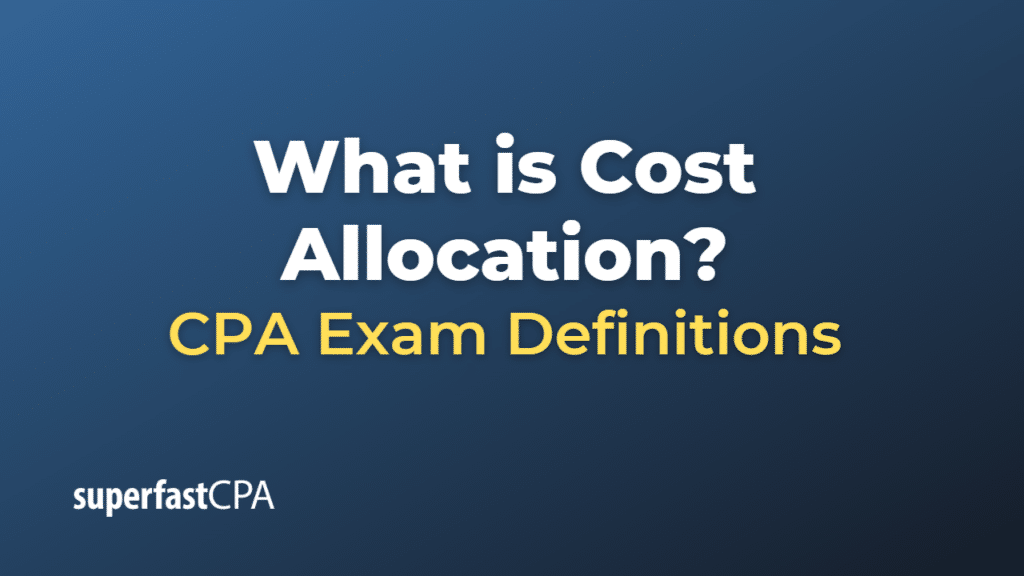Cost Allocation
Cost allocation is the process of assigning indirect costs (also known as overhead or shared costs) to different cost objects, such as products, services, departments, or projects, in a systematic and rational manner. Indirect costs are those costs that cannot be directly traced to a specific cost object or are not economically feasible to trace directly. Examples of indirect costs include rent, utilities, depreciation, insurance, and administrative expenses.
Cost allocation serves several purposes in organizations:
- Determine the full cost of products or services: Cost allocation helps organizations understand the complete cost structure of their products or services by assigning indirect costs to them, in addition to the direct costs (e.g., direct materials and direct labor).
- Support decision-making: Cost allocation provides essential information for management decision-making, such as pricing, resource allocation, budgeting, and forecasting.
- Evaluate performance: Cost allocation is vital for evaluating the performance of departments, projects, or products, as it helps organizations identify areas of efficiency and inefficiency and implement improvements.
- Justify costs: Allocating indirect costs to cost objects can help organizations justify the costs incurred in providing products or services, especially when dealing with clients, suppliers, or regulatory authorities.
- Compliance with accounting standards: Cost allocation is often required for financial reporting purposes, as it ensures compliance with Generally Accepted Accounting Principles (GAAP) or other relevant accounting standards.
There are various cost allocation methods used by organizations to allocate indirect costs, depending on the nature of the costs and the cost objects involved. Some common methods include:
- Direct allocation method: This method allocates each indirect cost item directly to the cost objects, typically based on a single allocation base, such as direct labor hours, machine hours, or square footage.
- Step-down method: This method allocates indirect costs sequentially, starting with the department or cost center that provides the highest level of support to other departments, and continuing in a hierarchical manner until all costs have been allocated.
- Reciprocal allocation method: This method accounts for the mutual support and interdependencies between departments by using a system of simultaneous equations to allocate indirect costs.
- Activity-based costing (ABC): This advanced method allocates indirect costs based on the activities that drive the costs, providing a more accurate representation of the resources consumed by different cost objects.
In summary, cost allocation is the process of assigning indirect costs to different cost objects in a systematic and rational manner. It is an essential part of cost accounting, as it helps organizations understand the full cost of their products or services, support decision-making, evaluate performance, and comply with accounting standards.
Example of Cost Allocation
Let’s consider an example of cost allocation at a furniture manufacturing company called “FurniCraft.”
FurniCraft manufactures two types of products: wooden chairs and wooden tables. The company incurs various indirect costs, such as rent, utilities, equipment maintenance, and administrative expenses, which cannot be traced directly to each product. To allocate these indirect costs to the products, FurniCraft follows these steps:
- Identify indirect costs: FurniCraft identifies the total indirect costs incurred during a specific period, such as a month. For example, suppose the total indirect costs for the month are $50,000.
- Select an allocation base: FurniCraft chooses an appropriate allocation base that has a logical relationship with the indirect costs. In this case, the company decides to use direct labor hours as the allocation base, as it believes that indirect costs are driven by the labor-intensive production process.
- Calculate the allocation rate: FurniCraft calculates the total direct labor hours spent on producing chairs and tables during the month. Suppose the company used 2,000 direct labor hours for chairs and 3,000 direct labor hours for tables, totaling 5,000 direct labor hours. The allocation rate per direct labor hour is:Allocation Rate = Total Indirect Costs / Total Direct Labor Hours Allocation Rate = $50,000 / 5,000 hours = $10 per hour
- Allocate indirect costs: FurniCraft allocates the indirect costs to the chairs and tables using the allocation rate and the direct labor hours spent on each product:
- Chairs: 2,000 direct labor hours × $10 per hour = $20,000
- Tables: 3,000 direct labor hours × $10 per hour = $30,000
Now, FurniCraft has allocated the indirect costs of $50,000 to its products: $20,000 to chairs and $30,000 to tables. This allocation helps the company understand the full cost of each product, make informed decisions about pricing and resource allocation, and evaluate the performance and profitability of each product line.
It’s important to note that the choice of allocation base and method can significantly impact the allocated costs and resulting insights. Therefore, organizations should carefully select an appropriate allocation base and method that best represents the cause-and-effect relationship between the cost objects and the indirect costs.













